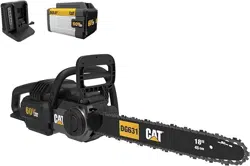Loading ...
Loading ...
Loading ...

6
EN
Decreasing the depth gauge height can lead to
SAFETY WARNINGS FOR BAT-
TERY PACK
a) Do not dismantle, open or shred battery pack.
storage in direct sunlight.
c) Do not short-circuit a battery pack. Do not store
battery packs haphazardly in a box or drawer
where they may short-circuit each other or be
short-circuited by other metal objects. When
battery pack is not in use, keep it away from other
the battery terminals together may cause burns or
d) Do not subject battery pack to mechanical shock.
e) In the event of battery leaking, do not allow the
liquid to come in contact with the skin or eyes. If
contact has been made, wash the affected area
with copious amounts of water and seek medical
advice.
f) Do not use any battery pack which is not designed
for use with the equipment.
g) Keep battery pack out of the reach of children.
h) Always purchase the battery pack recommended
by the device manufacturer for the equipment.
i) Keep battery pack clean and dry.
j) Wipe the battery pack terminals with a clean dry
cloth if they become dirty.
k) Battery pack needs to be charged before use.
Always use the correct charger and refer to the
manufacturer’s instructions or equipment manual
for proper charging instructions.
l) Do not leave battery pack on prolonged charge
when not in use.
m) After extended periods of storage, it may be
necessary to charge and discharge the battery pack
several times to obtain maximum performance.
®
.
provided for use with the equipment.
o) Retain the original product literature for future
reference.
p) Use only the battery pack in the application for
which it was intended.
q) Remove the battery pack from the equipment when
not in use.
r) Dispose of properly.
s) Do not mix cells of different manufacture, capacity,
size or type within a device.
t) Keep the battery away from microwaves and high
pressure.
SAVE THESE INSTRUCTIONS
Instructions concerning the proper techniques for
basic felling, limbing, and cross-cutting
1. Felling a tree
When bucking and felling operations are being
performed by two or more persons at the same time,
the felling operations should be separated from the
bucking operation by a distance of at least twice the
height of the tree being felled. Trees should not be felled
in a manner that would endanger any person, strike any
utility line or cause any property damage. If the tree
does make contact with any utility line, the company
The Chainsaw operator should keep on the uphill side
of the terrain as the tree is likely to roll or slide downhill
after it is felled.
An escape path should be planned and cleared as
necessary before cuts are started. The escape path
should extend back and diagonally to the rear of the
expected line of fall as illustrated in Figure 1.
Before felling is started, consider the natural lean of the
tree, the location of larger branches and the wind
direction to judge which way the tree will fall.
Remove dirt, stones, loose bark, nails, staples and wire
from the tree.
2. Notching undercut
Make the notch 1/3 the diameter of the tree,
perpendicular to the direction of falls as illustrated in
Figure 1. Make the lower horizontal notching cut (W)
chain or the guide bar when the second notch (X) is
being made.
3. Felling back cut
Make the felling back cut (Y) at least 50 mm higher than
the horizontal notching cut as illustrated in Figure 1.
Keep the felling back cut parallel to the horizontal
notching cut.
Make the felling back cut so enough wood is left to act
as a hinge. The hinge wood keeps the tree from twisting
and falling in the wrong direction. Do not cut through
Loading ...
Loading ...
Loading ...
